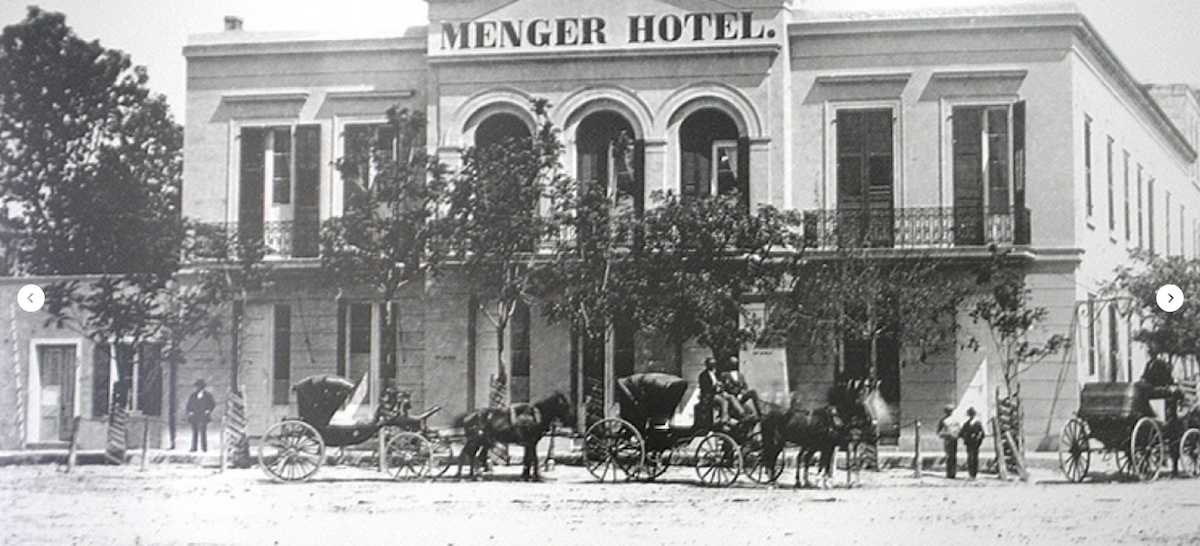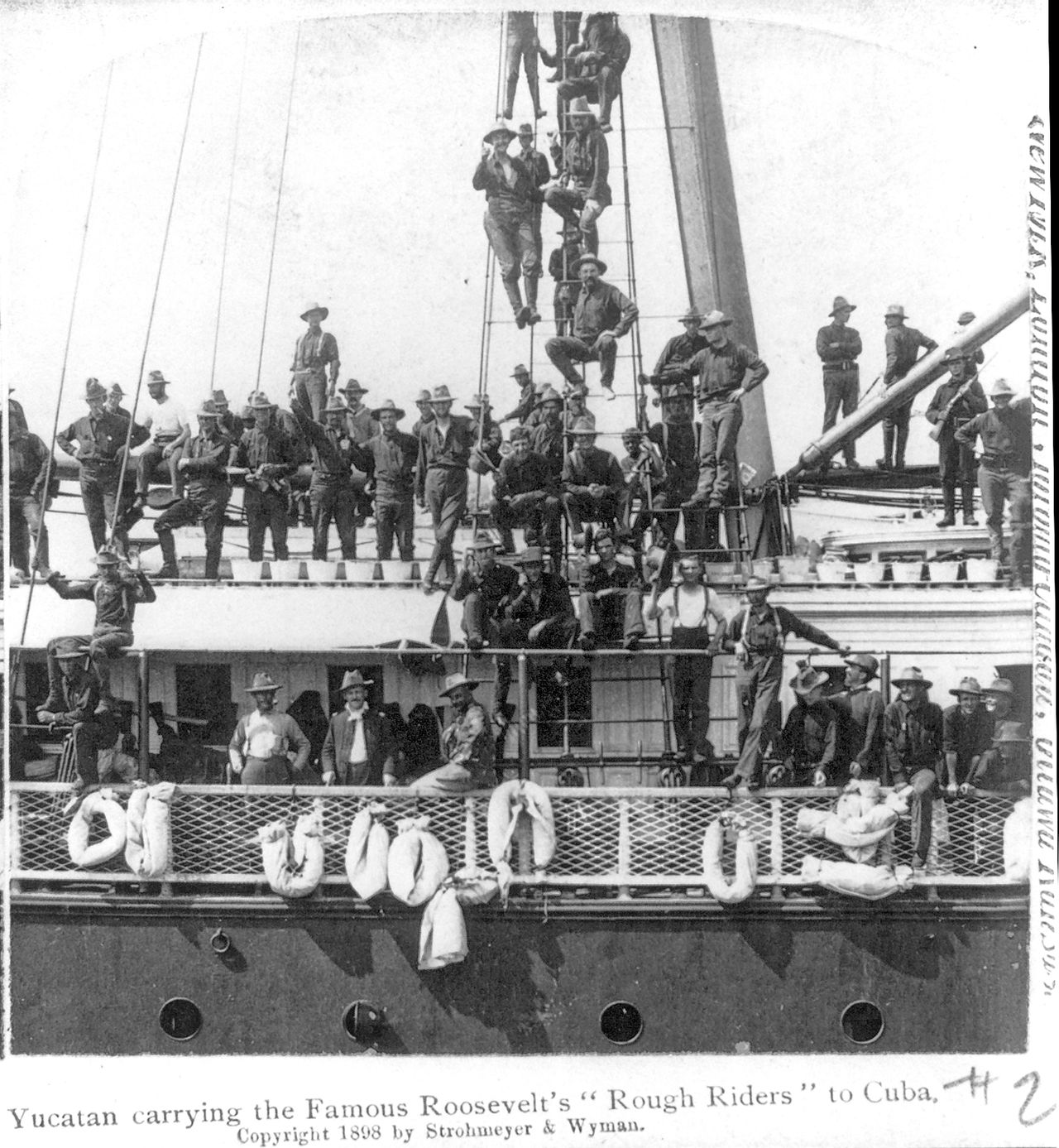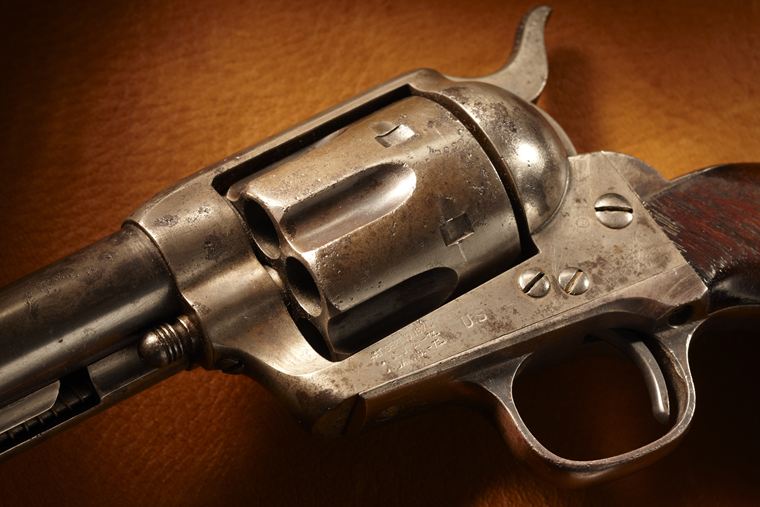This Colt Single Action Army .45 revolver was carried up San Juan Hill and Kettle Hill by Trooper Louis G. Bishop of Troop G, Ist US Volunteer Cavalry (Roosevelt's Rough Riders).
Days before Louis B. Bishop was issued his Colt Single Action Army .45, which is now on display at the NRA National Firearm Museum, he likely walked through a plaza in San Antonio, Texas, adjacent to the Menger Bar. The year was 1898. He was 22 years-old, and his plan was to sign up for the 1st United States Volunteer Calvary, famously known as Roosevelt’s Rough Riders.
The plaza belonged to Menger Hotel as did the bar by the same name. Its surface was built to accommodate pockets of vegetation including palm trees, likely Mexican fan palm trees, native to Sonora and the Baja California Sur in northwestern Mexico. And nearby, steps down from the plaza, Theodore Roosevelt had set up a recruiting station at Menger’s Bar.

22-year-old Louis B. Bishop volunteered for Theodore Roosevelt's Rough Riders at Menger's Bar, inside the hotel by the same name. The hotel still exists today. Soon after, Bishop was issued the Colt Single Action Army .45 that is now on display at the NRA's Firearms Museum. Photo: Menger Hotel
“With the ranks filling quickly, (Bishop) was assigned to Troop G, a unit that would be commanded by Captain William Llewellen,” wrote Doug Wicklund, NRA Museums Senior Curator. "But overseeing Llewellen and other officers was a doughty Lt. Colonel that had until recently been in government service as the assistant Secretary of the Navy, Theodore Roosevelt. Using his influence, Roosevelt was able to get his men outfitted with somewhat better arms than the regulars.”
According to Wicklund's research, two firearms were issued.
“For shoulder arms, the Rough Riders received the smokeless powder .30-40 Krag-Jorgensen carbine instead of the .45-70 blackpowder Trapdoor Springfield rifle," he wrote. "The Krag offered a five-shot magazine that could be quickly topped up in battle, but the single-shot Trapdoor was slower to load and belched forth a cloud of smoke with every shot.
“For a handgun, both regular and volunteer troops received the same model of revolver, the Colt Single Action Army .45. The troopers of the Rough Riders, being volunteer cavalry, were to each receive their Colts. But in the regular infantry, only sergeants and officers were issued handguns. Some of these Colts were well-worn, veterans of many campaigns in the Indian Wars, but others were a bit newer.”
The time between when Bishop signed up for the Rough Riders and the moment he was engaged in active battle was a shockingly brief interlude. Soon, a quick-moving chain of events would take Louis Bishop and his Colt revolver from San Antonio to Florida and on to Cuba where they’d wage a campaign in the Spanish-American War.

Rough Riders heading to Cuba aboard the steamship Yucatan in 1898. Photo: Library of Congress (Wikipedia)
Things started off in utter chaos — a complete train wreck in today's terms — that would result in Bishop and his company arriving without their mounts, forced into infantry work they hadn’t trained for.
“There were 47 officers and 994 enlisted men that emerged from training and headed to Florida, prepared to board their transport to Cuba," according to the NRA's Wicklund. "The twelve companies of Rough Riders were split up heading onto the railroad pier, with Roosevelt and eight companies near the head of the loading procession there in Tampa on May 29, 1898.
"Things were disorganized and Roosevelt took full advantage, boarding his first group of troops, understanding it would be harder to force them off the vessel. The confusing situation became worse. While the first Rough Riders were permitted to remain on board, their horses and mules did not board, and neither did the trailing four companies. The urgency of the day resulted in Roosevelt’s Rough Riders being shipped off to Cuba, sans mounts and some equipment. The men had little beyond their arms and uniforms with them."
"As cavalrymen, the Rough Riders were ill-prepared to fall in for infantry assignments in Cuba, but without their mounts there wasn’t much else they could do.”
Initially, the Rough Riders encountered a skirmish on the Spanish outpost of Las Guasimas before continuing on to Santiago, just east of San Jaun Hill. Remember, these men had almost nothing by way of equipment outside of their firearms, the clothes on their backs and a small supply of food. Once at Santiago, Roosevelt and his men were supposed to create a diversion while the main American force attacked a Spanish stronghold.
But instead, Roosevelt lead his Rough Riders — along with others outside of his own company — to charge ahead.
Supported by rapid fire from Gatling guns, the men, “moved uphill in short 'charges' towards San Juan Heights, taking Kettle Hill despite fierce Spanish resistance," according to the NRA post. "The Rough Riders faced enemy forces also armed with smokeless rifles capable of rapid firing, but with Gatling support fire, the 1st US Volunteer Cavalry, with only Roosevelt briefly mounted on his horse Texas taking the summit and tightening the American encirclement about the city of Santiago de Cuba. Somewhere in the fog of battle here was Trooper Bishop, armed with carbine and revolver, moving towards the summit with his fellows. The victory of the Rough Riders made it possible for the campaign to be quickly concluded.”
About Louis Bishop's Colt Single Action Army .45
In its original configuration, this Single Action Army had a 7 1/2-inch barrel that was shortened to 5 1/2 inches, perhaps before the Spanish-American War.
On August 14, 1898, the returning Rough Riders came off the boat at Montauk, New York to be met by many of their counterparts that hadn’t made the Cuba connection. The next month was filled with celebration, honoring the men and their commander.
On September 15, the regiment formally disbanded, returning the government-issued arms and supplies they had received. Louis B. Bishop’s revolver left his possession, returning to a government arsenal. But thanks to records kept in the National Archives, we can definitively track this revolver to a brief period in history in Cuba, where Bishop and Roosevelt were together in military service.
Bishop passed away on June 27, 1957 and is interred in Rockport, Indiana. His commanding officer Theodore Roosevelt was to receive the Medal of Honor 80 years after his own death.
Louis Bishop’s Colt is on display at the National Firearms Museum in Fairfax, Virginia, not far from a Colt M1895 “potato-digger” that also served on San Juan Heights.
— Doug Wicklund, NRA Museums Senior Curator
To read more about Louis Bishop's Colt Single Action Army, go here.







